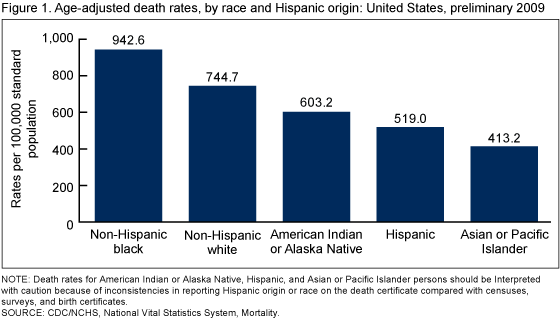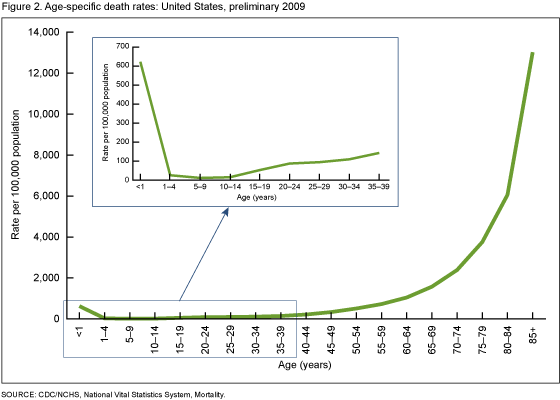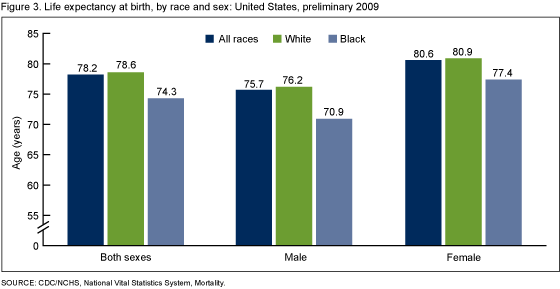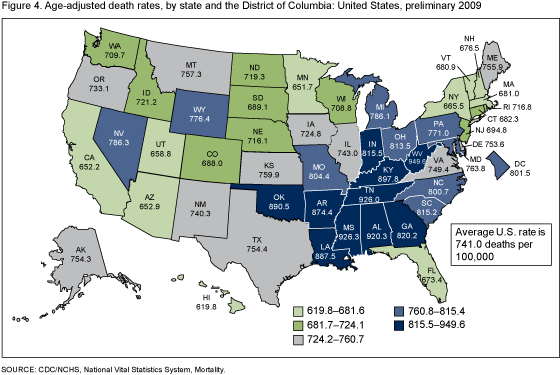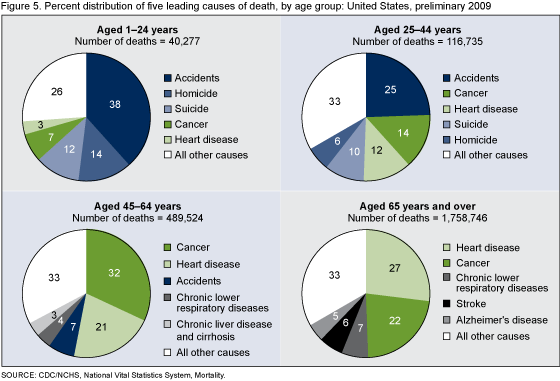Death in the United States, 2009
On This Page
- Key findings
- Does the risk of dying differ by race and ethnicity?
- Are there differences by age in the risk of dying?
- How long can we expect to live?
- Do death rates vary by state?
- What are the leading causes of death?
- Do leading causes of death change rank?
- Summary
- Definitions
- Data sources and methods
- About the author
- References
- Suggested citation
NCHS Data Brief No. 64, July 2011
PDF Version (729 KB)
Arialdi M. Miniño, M.P.H., Division of Vital Statistics
Key findings
Data from the National Vital Statistics System, Mortality
- In 2009, the age-adjusted death rate for the United States reached a record low of 741.0 per 100,000 population. The non-Hispanic black population had the highest mortality (942.6).
- Life expectancy at birth reached a record high of 78.2 years. White females had the longest life expectancy (80.9 years), followed by black females (77.4 years).
- The gap in life expectancy between white persons and black persons declined by 22 percent between 2000 and 2009. The race differential was 4.3 years in 2009.
- States in the Southeast region had higher death rates than those in other regions of the country.
- In 2009, the five leading causes of death were heart disease, cancer, chronic lower respiratory diseases, stroke, and accidents.
Mortality in the United States is best summarized by the age-adjusted death rate—a measure that accounts for changes in the age distribution of the population. This rate has declined in an almost uninterrupted manner since 1960. The death rate is now 45 percent lower than in 1960 (declining from 1,339.2 per 100,000 standard population in 1960 to 741.0 in 2009) (1,2). Although age-adjusted mortality has declined for all demographic groups over a period of many decades, long-standing gaps between black and white populations and between male and female populations have begun to narrow only since the mid-1990s. Many of the recent improvements in death rates and life expectancy for all population groups can be attributed to ongoing reductions in death rates from major causes of death, such as heart disease, cancer, stroke, and chronic lower respiratory diseases (1). The figures presented in this report are based on preliminary mortality data for 2009.
Keywords: death rate, mortality, National Vital Statistics System, life expectancy
Does the risk of dying differ by race and ethnicity?
In 2009, the highest mortality was observed for the non-Hispanic black population, followed by the non-Hispanic white population (Figure 1).
Death rates for all ethnic groups have generally been decreasing, at least since 1950 (2).
Compared with rates for 2000, the Hispanic population experienced the largest decrease in mortality (22.0 percent), while the non-Hispanic white population experienced the smallest mortality decline (13.0 percent) (1,3).
Are there differences by age in the risk of dying?
Death rates by age are lowest among 5- to 9-year-olds (Figure 2). In 2009, 72.3 percent of all deaths occurred among those aged 65 and over, and 30.1 percent occurred at age 85 and over.
Compared with rates for 2000, the largest decreases in age-specific death rates have occurred among those under age 20 or over age 59 (3,4).
How long can we expect to live?
U.S. life expectancy in 2009 was the highest in recorded history, reaching 78.2 years (or about 78 years and 10 weeks). Since 2000, life expectancy has increased by 1.8 percent (or approximately 17 months) for the general population (from 76.8 to 78.2 years), by 2.1 percent for males, and by 1.6 percent for females (1,3). Life expectancy at age 65 was 18.8 years in 2009, an increase of 6.8 percent since 2000 (3–5).
White females continue to have the longest life expectancy (80.9 years), followed by black females (77.4 years) (Figure 3). The life expectancy gap between the white and black populations declined 22 percent from 2000 to 2009. Despite this progress, the race differential stood at 4.3 years in 2009 (1,3). The gap between the white and black populations in life expectancy at age 65 has declined 19 percent (from 1.6 to 1.3 years) since 2000 (5).
Do death rates vary by state?
States experience different risks of mortality. Hawaii has the lowest age-adjusted death rate (619.8 deaths per 100,000 population) of all the states, 16.4 percent lower than the average rate for the United States (741.0). West Virginia had the highest state age-adjusted death rate in 2009, 28.2 percent higher than the average U.S. rate.
In general, states in the Southeast region have higher rates than those in other regions of the country. Louisiana, for example, is typical of the region and has an age-adjusted death rate of 887.5 deaths per 100,000 population (3). States in other regions of the country, such as Illinois in the Midwest (743.0 deaths per 100,000 population) and Oregon in the West (733.1 deaths per 100,000 population), have rates that are more comparable with the average U.S. rate (3) (Figure 4).
What are the leading causes of death?
In 2009, five major causes of death (heart disease, cancer, chronic lower respiratory diseases, stroke, and accidents) accounted for almost 64 percent of all deaths in the United States (3). However, this general profile of leading causes changes substantially based on a decedent’s age.
The leading causes of death for those aged 1–24 are external causes (i.e., accidents, homicide, and suicide), followed by cancer and heart disease. This pattern (of external causes accounting for more deaths than chronic conditions) shifts noticeably as age increases. In older age groups, chronic conditions account for more deaths than do external causes of injury.
Accidents, for example, accounted for 38 percent of all deaths among persons aged 1–24. Heart disease, on the other hand, accounted for only 3 percent of all deaths for this same age group. For persons aged 65 and over, heart disease is the leading cause of death, accounting for 27 percent of all deaths in this age group, whereas accidents is not one of the five leading causes of death for those aged 65 and over (Figure 5).
Do leading causes of death change rank?
Between 1980 and 2007, the three leading causes of death (heart disease, cancer, and stroke) did not change in order of ranking. In 2008, however, chronic lower respiratory diseases replaced stroke as the third leading cause of death, and stroke fell to the fourth leading cause (6)(Figure 6). This ranking order remains in 2009 (3). It is worth noting that because deaths from heart disease have tended to decrease throughout the 1980–2009 period, it is likely that at some point in the near future heart disease will no longer be the leading cause of death in the United States.
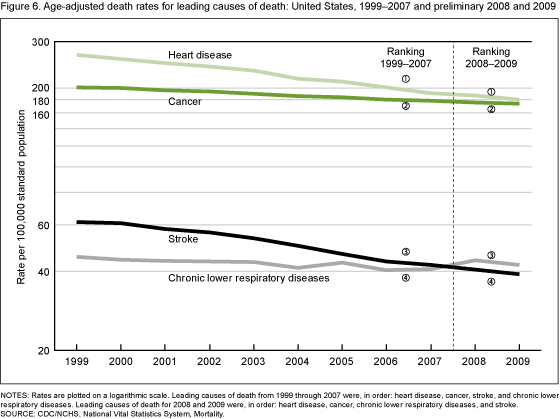
Summary
Mortality in 2009 continued to decline among most groups defined by sex, age, and race and Hispanic ethnicity. With few exceptions, the trend is one of increases in life expectancy at birth for the population as a whole and, in 2009, for white males and females in particular (1,3,5). Although continuing declines in mortality are slowly reducing long-standing gaps in life expectancy between the black and white populations, disparities in mortality across ethnic and racial groups persist (1,3–5). Many of these increases in life expectancy are attributed to reductions in the rates of death from the major causes of death, namely heart disease, cancer, stroke, and chronic lower respiratory diseases (1). Beginning in 2008, chronic lower respiratory diseases replaced stroke as the third leading cause of death, while stroke fell to the fourth leading cause (6).
Definitions
Cause-of-death classification: Medical information—including injury diagnoses and external causes of injury—that is entered on death certificates filed in the United States is classified and coded in accordance with the International Statistical Classification of Diseases and Related Health Problems, Tenth Revision (ICD–10) (7).
Death rates: Except for data points showing rates prior to the year 2000, the rates in this report use population estimates based on the 2000 census. Population for the year 2000 is enumerated as of April 1 and, for subsequent years, populations are estimated as of July 1 of the respective year. These population estimates are available on the NCHS website (8). Age-adjusted death rates are useful when comparing different populations because they remove the potential bias that can occur when the populations being compared have different age structures. NCHS uses the “direct” method of standardization. See the “Technical Notes” of “Deaths: Preliminary Data for 2009” (3) for more discussion.
Life expectancy: Data showing life expectancy for 2000–2009 are based on a newly revised methodology and may differ from figures previously published. See the “Technical Notes” of “Deaths: Preliminary Data for 2009” (3) for more discussion.
Data sources and methods
Data in this report (preliminary mortality data for 2009) are based on a large portion (98 percent of the demographic file and 96 percent of the medical file) of the statistical records that are continuously received by the National Center for Health Statistics from states’ vital registration systems. This portion of records is inflated to better estimate final numbers, using independent record tallies as control factors. Tallies are provided by the states and registration areas.
The figures shown in this report reflect information that is collected on the death certificates that are filed in each of the independent registration areas throughout the United States.
About the author
Arialdi M. Miniño is a statistician with the Centers for Disease Control and Prevention’s National Center for Health Statistics, Division of Vital Statistics.
References
- Xu JQ, Kochanek KD, Murphy SL, Tejada-Vera B. Deaths: Final data for 2007. National vital statistics reports; vol 58 no 19. Hyattsville, MD: National Center for Health Statistics. 2010.
- National Center for Health Statistics. Health, United States, 2010. Table 24. Hyattsville, MD. 2011.
- Kochanek KD, Xu JQ, Murphy SL, et al. Deaths: Preliminary data for 2009. National vital statistics reports; vol 59 no 4. Hyattsville, MD: National Center for Health Statistics. 2011.
- Miniño AM, Arias E, Kochanek KD, et al. Deaths: Final data for 2000. National vital statistics reports; vol 50 no 15. Hyattsville, MD: National Center for Health Statistics. 2002.
- National Center for Health Statistics. Health, United States, 2010. Table 22. Hyattsville, MD. 2011.
- Miniño AM, Xu JQ, Kochanek KD. Deaths: Preliminary data for 2008. National vital statistics reports; vol 59 no 2. Hyattsville, MD: National Center for Health Statistics. 2010.
- World Health Organization. International statistical classification of diseases and related health problems, tenth revision. Geneva. 1992.
- National Center for Health Statistics, National Vital Statistics System. U.S. census populations with bridged race categories [online].
Suggested citation
Miniño AM. Death in the United States, 2009. NCHS data brief, no 64. Hyattsville, MD: National Center for Health Statistics. 2011.
Copyright information
All material appearing in this report is in the public domain and may be reproduced or copied without permission; citation as to source, however, is appreciated.
National Center for Health Statistics
Edward J. Sondik, Ph.D., Director
Jennifer H. Madans, Ph.D., Associate Director for Science
Division of Vital Statistics
Charles J. Rothwell, M.S., Director
- Page last reviewed: November 6, 2015
- Page last updated: July 13, 2011
- Content source:


 ShareCompartir
ShareCompartir
